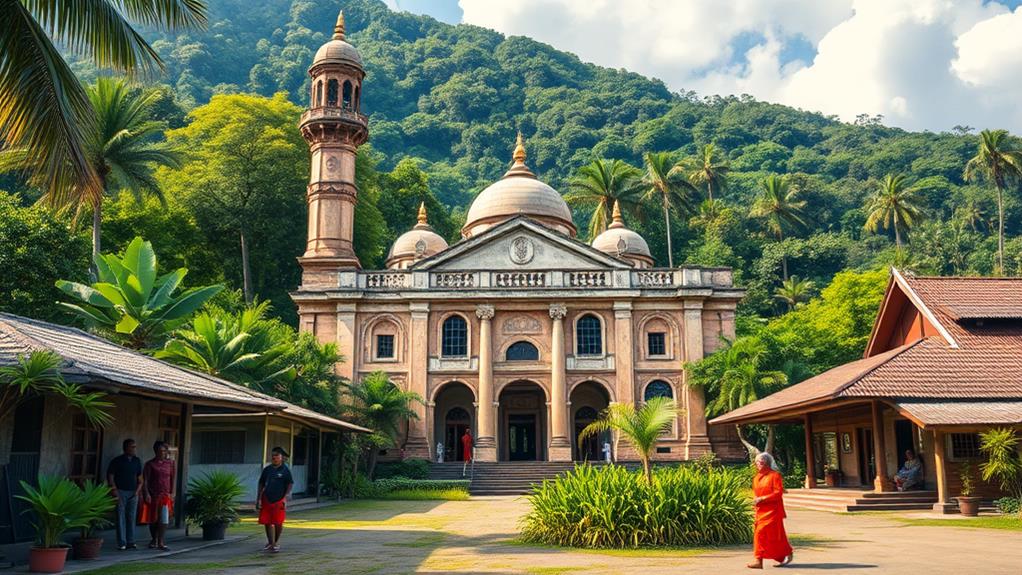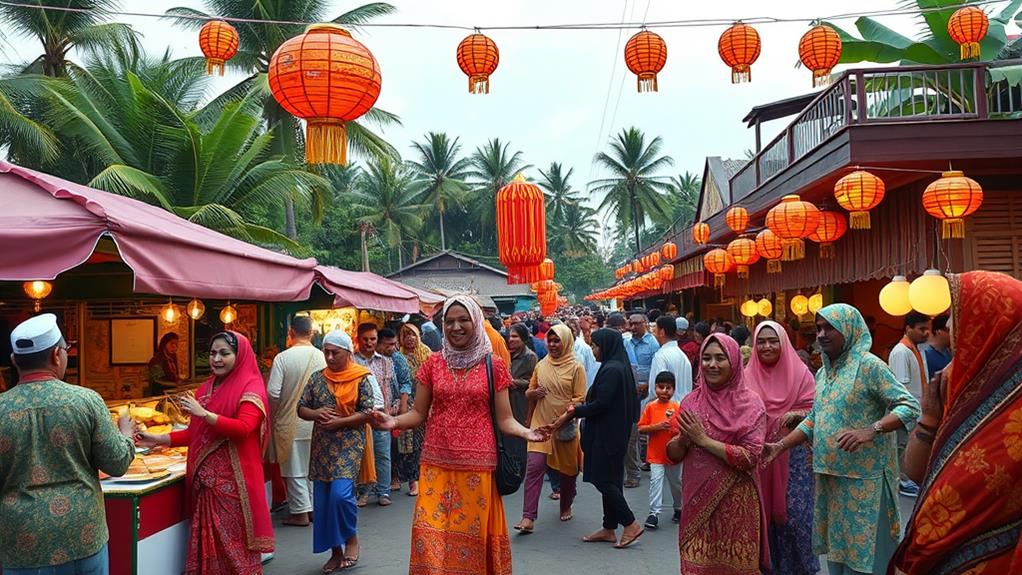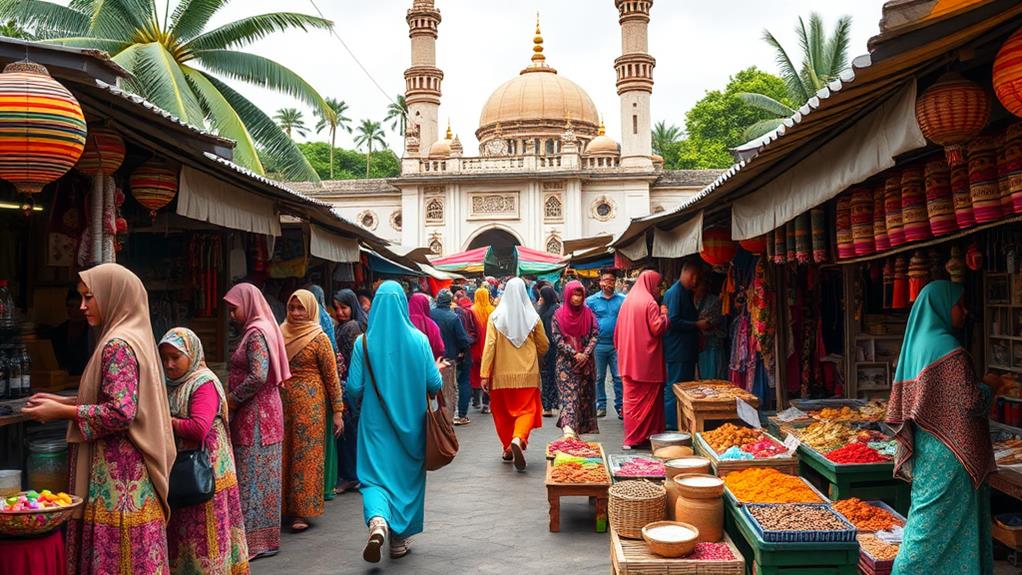Islam's History in the Philippines
Islam arrived in the Philippines in the 14th century, leading to the establishment of the first mosque and the rise of sultanates like Sulu and Maguindanao.
Today, about 6.4% of the population identifies as Muslim, with a strong presence in Mindanao and the Bangsamoro region.
Rich Traditions and Cultural Practices
You'll encounter rich traditions, such as the celebrations of Eid, which marks the end of Ramadan.
Another example is the art of intricate weaving, a skill that has been passed down through generations in these communities.
Community Resilience
Despite historical challenges and ongoing socio-economic issues, these communities demonstrate resilience and unity.
Their fascinating stories are a testament to their ability to thrive in the face of adversity.
Historical Context of Islam

Islam's introduction to the Philippines occurred in the 14th century through the efforts of Sunni Shaykh Makhdum Karim and Minangkabau Prince Rajah Baguinda. They established the first Muslim communities, which can be traced back to the Sheik Karimol Makhdum Mosque in Simunul, Mindanao, the first mosque built in the country. This mosque became a hub for Islamic worship and social life.
The spread of Islam led to the emergence of major sultanates like Sulu and Maguindanao, which created centralized political and religious systems. These systems thrived through trade and cultural interactions.
However, the Spanish conquest beginning in 1565 drastically altered this landscape. The colonizers suppressed Islam, often referring to practitioners derogatorily as "Moro."
Despite suppression, Islam persisted as a minority religion in the Philippines. Today, the Muslim population, concentrated mainly in Mindanao, Palawan, and the Sulu Archipelago, reflects a complex history marked by resilience amid historical conflicts and socio-economic hurdles.
This underscores the enduring legacy of Islam in the archipelago.
Demographic Overview
Approximately 6.4% of the Philippine population identifies as Muslim, which translates to around 7 million individuals according to the 2020 census. This represents a growth from 6.0% in 2015, indicating a dynamic shift in the Muslim demographic landscape.
The National Commission on Muslim Filipinos estimates that the Muslim population could be closer to 11%, with the majority residing in Mindanao, Palawan, and the Sulu Archipelago.
In the Bangsamoro region, 91% of the 4.9 million residents identify as Muslim, reflecting the deep-rooted nature of Islam in these areas. The region is home to various ethnolinguistic groups, including the Iranun, Maguindanao, Maranao, Tausug, and Yakan, which contribute to the rich cultural diversity within these communities.
In urban settings, such as Zamboanga City and Manila, Muslims represent a smaller but significant demographic, with 1.29% in the National Capital Region.
The growth rate of the Muslim population significantly outpaces the national average, suggesting a vibrant and evolving identity.
Cultural Practices and Traditions

Cultural Practices and Traditions in the Philippines
The Philippines, with a significant Muslim population, boasts a rich cultural heritage and strong community bonds. In the Bangsamoro region, vibrant celebrations showcase Islamic values and communal spirit.
Islamic Festivals and Celebrations
Eid al-Fitr and Eid al-Adha are significant festivals marked by prayer, charity, and communal gatherings, bringing people together and fostering connections among families and friends.
Traditional Crafts and Art Forms
The Maranao and Tausug ethnolinguistic groups are renowned for their intricate weaving of "tapis" and the creation of "malong", showcasing their exceptional skill and artistry.
Sufism and Spiritual Growth
Rituals and gatherings at centers like the Darul Abdulqadir Jilani Dergah focus on spiritual growth and community engagement, highlighting the importance of Sufism in the region.
Diversity in Islamic Practices
The Balik Islam movement, which began in the 1970s, has led to a growing diversity in practices and interpretations, contributing to the rich tapestry of Islamic heritage in the Philippines.
Community Feasting and Bonding
Shared meals during religious observances reinforce bonds among community members, strengthening social ties and fostering a sense of belonging.
These cultural practices and traditions not only celebrate Islamic faith but also create a strong sense of identity and belonging within the diverse Filipino landscape.
Political Landscape and Challenges
Navigating the political landscape in the Bangsamoro region reveals a complex interplay of historical grievances and contemporary challenges. The establishment of the Bangsamoro Autonomous Region in Muslim Mindanao (BARMM) aimed to provide political autonomy, but issues surrounding political representation and governance persist.
Despite earlier efforts like the Autonomous Region in Muslim Mindanao (ARMM) and peace negotiations led by the Moro National Liberation Front (MNLF) and the Moro Islamic Liberation Front (MILF), socio-economic marginalization continues to plague Muslim communities.
Internal conflicts among various armed groups, including splinter factions like Abu Sayyaf, complicate the situation further, hampering stability and peace efforts. The governance challenges often overlook the unique cultural needs of these communities, leading to disparities in education and employment opportunities.
Four key challenges face the region:
Limited engagement of Muslim communities in governance hinders their political representation. For instance, the lack of representation in decision-making bodies has led to policies that neglect the needs of Muslim communities.
Disparities in access to resources and opportunities perpetuate socio-economic marginalization. Muslim communities have limited access to quality education, healthcare, and employment opportunities, making them vulnerable to poverty and exploitation.
Rivalries among armed groups affect stability, as internal conflicts and power struggles hinder peace efforts. The presence of splinter factions like Abu Sayyaf further complicates the situation.
Policies failing to address cultural needs are a major governance challenge. The region's unique cultural heritage and needs are often overlooked, leading to ineffective policies that don't address the root causes of marginalization.
Understanding these dynamics is crucial for fostering a more inclusive political environment.
External Influences and Movements

The development of Muslim communities in the Philippines has been significantly shaped by external influences and movements.
Bruneian raids in the 15th century established early Muslim settlements like Tondo, catalyzing the formation of vassal states. This led to the creation of Muslim-ruled states in the Philippines, which played a crucial role in the spread of Islam.
Cultural exchange, facilitated by Zheng He's voyages, led to urbanization and diverse practices within Muslim communities. For instance, the exchange of goods and ideas with Chinese traders introduced new architectural styles, such as the use of pagoda-like minarets in mosques.
The Nurcu movement emphasizes a return to core Islamic principles, fostering interfaith dialogue. This movement promotes a more tolerant and inclusive understanding of Islam, encouraging cooperation between Muslims and non-Muslims.
The Hizmet movement promotes educational excellence through school initiatives. By establishing schools and educational institutions, Hizmet aims to improve access to quality education and promote social mobility among Muslim communities.
Revivalist movements, such as Tablighi Jamaat, focus on community engagement to strengthen Islamic practices. These movements organize community outreach programs, encouraging Muslims to return to their religious roots and practice their faith more devoutly.
Despite facing scrutiny due to its unique beliefs, the Ahmadiyya community actively engages in humanitarian efforts, enriching the socio-cultural fabric. Ahmadiyya's humanitarian work, such as providing disaster relief and promoting education, has contributed to the betterment of society as a whole.
These external influences and movements haven't only shaped religious practices but also encouraged community cohesion, fostering an environment where diverse Islamic expressions can thrive.
Questions and Answers
Are One of the Largest Islamic Groups in the Philippines?
The Maguindanao are one of the largest Islamic groups in the Philippines. They've a rich Islamic history and cultural diversity, which is showcased through their vibrant religious festivals.
For example, they celebrate the Hariraya Puasa, a festival that marks the end of Ramadan.
The Maguindanao also make significant economic contributions to local economies through agriculture and trade. They're known for their expertise in farming and trading goods such as rice, corn, and coffee.
Despite facing social challenges and historical conflicts, the Maguindanao are actively engaged in political representation and educational initiatives.
They strive to promote understanding and harmony within their diverse society through interfaith dialogue.
Is It Possible to Separate Mindanao From the Philippines?
Separating Mindanao from the Philippines is a complex issue.
Mindanao's historical context and ongoing political challenges make independence a challenging goal.
The region's cultural identity and ethnic diversity are unique, with 18 major ethnic groups, each with their own language and traditions.
However, economic implications and social cohesion are significant hurdles. Mindanao's economy is heavily dependent on the national government, and separation would require significant economic restructuring.
Peace agreements, such as the one with the Moro National Liberation Front (MNLF), aim to bring stability to the region. The MNLF, a separatist group, signed a peace agreement with the Philippine government in 1996, which led to the creation of the Autonomous Region in Muslim Mindanao (ARMM).
However, global perspectives and regional dynamics pose additional challenges. The region's proximity to neighboring countries and the presence of international organizations, such as the Organization of Islamic Cooperation, influence the region's politics and economy.
Ultimately, achieving independence requires navigating deeply rooted complexities and fostering unity. This involves addressing the region's historical grievances, reconciling differences between ethnic groups, and creating a unified vision for the future.
Why Is Mindanao Full of Muslims?
Mindanao's Islamic history dates back centuries, shaping the region's demographics today.
The region's cultural influences, stemming from centuries of trade and migration patterns, have fostered a unique Mindanao identity. For example, the Sulu Archipelago, a chain of islands in southwestern Mindanao, was a major hub for Islamic traders and scholars from the Middle East and India, introducing Islam to the region in the 14th century.
The Muslim majority in Mindanao reflects deep-rooted traditions.
Religious practices in Mindanao have been further strengthened by colonial impacts that marginalized these communities. The American colonization of the Philippines in the early 20th century, for instance, led to the relocation of Christian settlers to Mindanao, sparking tensions with the existing Muslim population.
Socioeconomic factors contribute to ongoing challenges in Mindanao.
However, interfaith relations and the political landscape continue to evolve, highlighting the resilience and complexity of Mindanao's Muslim population.
Despite these challenges, efforts towards peace and autonomy, such as the Bangsamoro Organic Law, aim to address the region's historical grievances and promote development.
What Are the Moro Groups in the Philippines?
The Moro groups in the Philippines consist of various ethnicities. These groups, including the Maguindanao, Maranao, Tausug, and Yakan, each have their own distinct cultural traditions and religious practices.
Their history is marked by political movements and identity formation, which have been shaped by economic challenges and land disputes.
These communities have rich social structures, with complex systems of governance, kinship, and social relationships.
Interfaith relations also play a significant role, as Moro groups have learned to coexist with other religious and ethnic groups in the Philippines.
Education systems in Moro communities reflect their unique contexts. For example, some communities place a strong emphasis on Islamic education, while others incorporate traditional practices and oral traditions into their educational systems.
Understanding these dynamics is essential for appreciating the heritage and resilience of Moro groups.